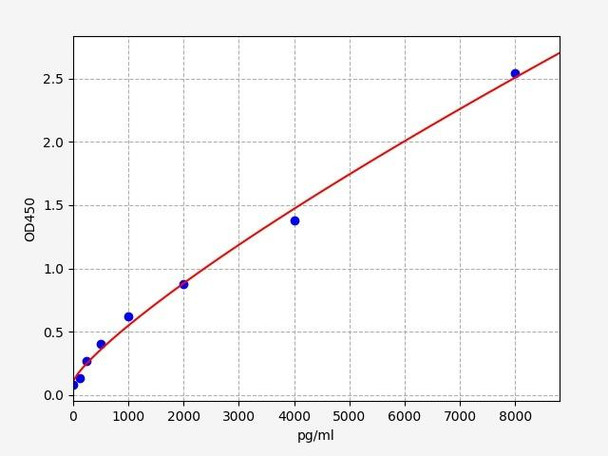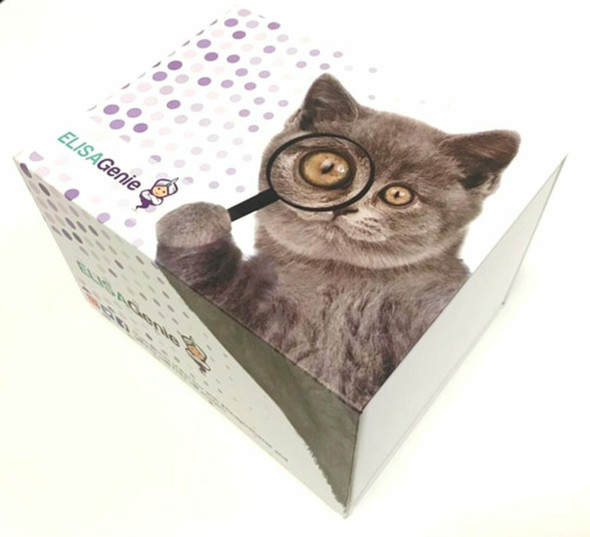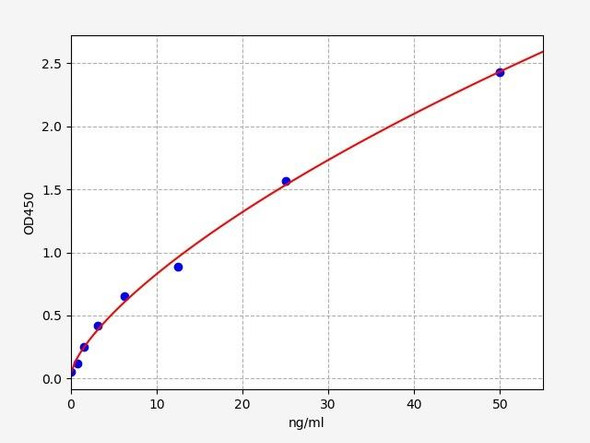Description
Human TMPRSS6 (Transmembrane protease serine 6) ELISA Kit (HUFI04765)
The Human TMPRSS6 (Transmembrane Protease Serine 6) ELISA Kit is specifically designed for the precise detection of TMPRSS6 levels in human serum, plasma, and cell culture supernatants. With its superior sensitivity and specificity, this kit delivers consistent and accurate results, making it an invaluable tool for various research applications.TMPRSS6 is a transmembrane serine protease that plays a vital role in iron homeostasis by regulating the expression of hepcidin, a key hormone involved in iron metabolism.
Dysregulation of TMPRSS6 has been linked to disorders such as iron deficiency anemia and hereditary hemochromatosis, highlighting its significance as a potential biomarker for these conditions.By utilizing the Human TMPRSS6 ELISA Kit, researchers can uncover valuable insights into the role of TMPRSS6 in iron regulation and its implications for various diseases, paving the way for the development of novel therapeutic strategies and diagnostic approaches.
| Product Name: | Human TMPRSS6 (Transmembrane protease serine 6) ELISA Kit |
| Product Code: | HUFI04765 |
| Size: | 96 Assays |
| Alias: | IRIDA ELISA Kit, Matriptase 2 ELISA Kit, TMPRSS6 ELISA Kit |
| Detection method: | Sandwich ELISA, Double Antibody |
| Application: | This immunoassay kit allows for the in vitro quantitative determination of Human TMPRSS6 (Transmembrane protease serine 6) concentrations in serum plasma and other biological fluids. |
| Sensitivity: | < 75pg/ml |
| Range: | 125-8000pg/ml |
| Storage: | 4°C for 6 months |
| Note: | For Research Use Only |
| Recovery: | Matrices listed below were spiked with certain level of Human TMPRSS6 (Transmembrane protease serine 6) and the recovery rates were calculated by comparing the measured value to the expected amount of Human TMPRSS6 (Transmembrane protease serine 6) in samples. | ||||||||||||||||
| |||||||||||||||||
| Linearity: | The linearity of the kit was assayed by testing samples spiked with appropriate concentration of Human TMPRSS6 (Transmembrane protease serine 6) and their serial dilutions. The results were demonstrated by the percentage of calculated concentration to the expected. | ||||||||||||||||
| |||||||||||||||||
| CV(%): | Intra-Assay: CV<8% Inter-Assay: CV<10% |
| Component | Quantity | Storage |
| ELISA Microplate (Dismountable) | 8×12 strips | 4°C for 6 months |
| Lyophilized Standard | 2 | 4°C/-20°C |
| Sample/Standard Dilution Buffer | 20ml | 4°C |
| Biotin-labeled Antibody(Concentrated) | 120ul | 4°C (Protect from light) |
| Antibody Dilution Buffer | 10ml | 4°C |
| HRP-Streptavidin Conjugate(SABC) | 120ul | 4°C (Protect from light) |
| SABC Dilution Buffer | 10ml | 4°C |
| TMB Substrate | 10ml | 4°C (Protect from light) |
| Stop Solution | 10ml | 4°C |
| Wash Buffer(25X) | 30ml | 4°C |
| Plate Sealer | 5 | - |
Other materials and equipment required:
- Microplate reader with 450 nm wavelength filter
- Multichannel Pipette, Pipette, microcentrifuge tubes and disposable pipette tips
- Incubator
- Deionized or distilled water
- Absorbent paper
- Buffer resevoir
| UniProt Protein Function: | TMPRSS6: Serine protease which hydrolyzes a range of proteins including type I collagen, fibronectin and fibrinogen. Can also activate urokinase-type plasminogen activator with low efficiency. May play a specialized role in matrix remodeling processes in liver. Plays a role in the regulation of iron homeostasis, a process involving HAMP. Required to sense iron deficiency and suppress activation of the HAMP promoter. Defects in TMPRSS6 are the cause of iron-refractory iron deficiency anemia (IRIDA); also known as hypochromic microcytic anemia with defect in iron metabolism or hereditary iron-handling disorder or pseudo-iron-deficiency anemia. Key features include congenital hypochromic microcytic anemia, very low mean corpuscular erythrocyte volume, low transferrin saturation, abnormal iron absorption characterized by no hematologic improvement following treatment with oral iron, and abnormal iron utilization characterized by a sluggish, incomplete response to parenteral iron. Mutations leading to abrogation of TMPRSS6 activity are associated with IRIDA due to elevated levels of hepcidin, a negative regulator of plasma iron pool (PubMed:20232450). Belongs to the peptidase S1 family. 4 isoforms of the human protein are produced by alternative splicing. |
| UniProt Protein Details: | Protein type:Membrane protein, integral; EC 3.4.21.-; Protease Chromosomal Location of Human Ortholog: 22q12.3 Cellular Component: extracellular space; integral to membrane; plasma membrane Molecular Function:protein binding; serine-type endopeptidase activity Biological Process: cellular iron ion homeostasis; fibrinolysis; iron ion homeostasis; membrane protein proteolysis; negative regulation of transcription from RNA polymerase II promoter; negative regulation of transcription, DNA-dependent; positive regulation of transcription from RNA polymerase II promoter; proteolysis Disease: Iron-refractory Iron Deficiency Anemia |
| NCBI Summary: | The protein encoded by this gene is a type II transmembrane serine proteinase that is found attached to the cell surface. The encoded protein may be involved in matrix remodeling processes in the liver. Alternative splicing results in multiple transcript variants. [provided by RefSeq, Jan 2014] |
| UniProt Code: | Q8IU80 |
| NCBI GenInfo Identifier: | 209572718 |
| NCBI Gene ID: | 164656 |
| NCBI Accession: | Q8IU80.3 |
| UniProt Secondary Accession: | Q8IU80,Q5TI06, Q6ICC2, Q6UXD8, Q8IUE2, Q8IXV8, B0QYB4 B0QYB7, B0QYB8, |
| UniProt Related Accession: | Q8IU80 |
| Molecular Weight: | 91,333 Da |
| NCBI Full Name: | Transmembrane protease serine 6 |
| NCBI Synonym Full Names: | transmembrane protease, serine 6 |
| NCBI Official Symbol: | TMPRSS6 |
| NCBI Official Synonym Symbols: | IRIDA |
| NCBI Protein Information: | transmembrane protease serine 6 |
| UniProt Protein Name: | Transmembrane protease serine 6 |
| UniProt Synonym Protein Names: | Matriptase-2 |
| Protein Family: | Transmembrane protease serine |
| UniProt Gene Name: | TMPRSS6 |
| UniProt Entry Name: | TMPS6_HUMAN |
*Note: Protocols are specific to each batch/lot. For the correct instructions please follow the protocol included in your kit.
Before adding to wells, equilibrate the SABC working solution and TMB substrate for at least 30 min at 37 °C. When diluting samples and reagents, they must be mixed completely and evenly. It is recommended to plot a standard curve for each test.
| Step | Protocol |
| 1. | Set standard, test sample and control (zero) wells on the pre-coated plate respectively, and then, record their positions. It is recommended to measure each standard and sample in duplicate. Wash plate 2 times before adding standard, sample and control (zero) wells! |
| 2. | Aliquot 0.1ml standard solutions into the standard wells. |
| 3. | Add 0.1 ml of Sample / Standard dilution buffer into the control (zero) well. |
| 4. | Add 0.1 ml of properly diluted sample ( Human serum, plasma, tissue homogenates and other biological fluids.) into test sample wells. |
| 5. | Seal the plate with a cover and incubate at 37 °C for 90 min. |
| 6. | Remove the cover and discard the plate content, clap the plate on the absorbent filter papers or other absorbent material. Do NOT let the wells completely dry at any time. Wash plate X2. |
| 7. | Add 0.1 ml of Biotin- detection antibody working solution into the above wells (standard, test sample & zero wells). Add the solution at the bottom of each well without touching the side wall. |
| 8. | Seal the plate with a cover and incubate at 37 °C for 60 min. |
| 9. | Remove the cover, and wash plate 3 times with Wash buffer. Let wash buffer rest in wells for 1 min between each wash. |
| 10. | Add 0.1 ml of SABC working solution into each well, cover the plate and incubate at 37 °C for 30 min. |
| 11. | Remove the cover and wash plate 5 times with Wash buffer, and each time let the wash buffer stay in the wells for 1-2 min. |
| 12. | Add 90 µL of TMB substrate into each well, cover the plate and incubate at 37 °C in dark within 10-20 min. (Note: This incubation time is for reference use only, the optimal time should be determined by end user.) And the shades of blue can be seen in the first 3-4 wells (with most concentrated standard solutions), the other wells show no obvious color. |
| 13. | Add 50 µL of Stop solution into each well and mix thoroughly. The color changes into yellow immediately. |
| 14. | Read the O.D. absorbance at 450 nm in a microplate reader immediately after adding the stop solution. |
When carrying out an ELISA assay it is important to prepare your samples in order to achieve the best possible results. Below we have a list of procedures for the preparation of samples for different sample types.
| Sample Type | Protocol |
| Serum | If using serum separator tubes, allow samples to clot for 30 minutes at room temperature. Centrifuge for 10 minutes at 1,000x g. Collect the serum fraction and assay promptly or aliquot and store the samples at -80°C. Avoid multiple freeze-thaw cycles. If serum separator tubes are not being used, allow samples to clot overnight at 2-8°C. Centrifuge for 10 minutes at 1,000x g. Remove serum and assay promptly or aliquot and store the samples at -80°C. Avoid multiple freeze-thaw cycles. |
| Plasma | Collect plasma using EDTA or heparin as an anticoagulant. Centrifuge samples at 4°C for 15 mins at 1000 × g within 30 mins of collection. Collect the plasma fraction and assay promptly or aliquot and store the samples at -80°C. Avoid multiple freeze-thaw cycles. Note: Over haemolysed samples are not suitable for use with this kit. |
| Urine & Cerebrospinal Fluid | Collect the urine (mid-stream) in a sterile container, centrifuge for 20 mins at 2000-3000 rpm. Remove supernatant and assay immediately. If any precipitation is detected, repeat the centrifugation step. A similar protocol can be used for cerebrospinal fluid. |
| Cell culture supernatant | Collect the cell culture media by pipette, followed by centrifugation at 4°C for 20 mins at 1500 rpm. Collect the clear supernatant and assay immediately. |
| Cell lysates | Solubilize cells in lysis buffer and allow to sit on ice for 30 minutes. Centrifuge tubes at 14,000 x g for 5 minutes to remove insoluble material. Aliquot the supernatant into a new tube and discard the remaining whole cell extract. Quantify total protein concentration using a total protein assay. Assay immediately or aliquot and store at ≤ -20 °C. |
| Tissue homogenates | The preparation of tissue homogenates will vary depending upon tissue type. Rinse tissue with 1X PBS to remove excess blood & homogenize in 20ml of 1X PBS (including protease inhibitors) and store overnight at ≤ -20°C. Two freeze-thaw cycles are required to break the cell membranes. To further disrupt the cell membranes you can sonicate the samples. Centrifuge homogenates for 5 mins at 5000xg. Remove the supernatant and assay immediately or aliquot and store at -20°C or -80°C. |
| Tissue lysates | Rinse tissue with PBS, cut into 1-2 mm pieces, and homogenize with a tissue homogenizer in PBS. Add an equal volume of RIPA buffer containing protease inhibitors and lyse tissues at room temperature for 30 minutes with gentle agitation. Centrifuge to remove debris. Quantify total protein concentration using a total protein assay. Assay immediately or aliquot and store at ≤ -20 °C. |
| Breast Milk | Collect milk samples and centrifuge at 10,000 x g for 60 min at 4°C. Aliquot the supernatant and assay. For long term use, store samples at -80°C. Minimize freeze/thaw cycles. |









